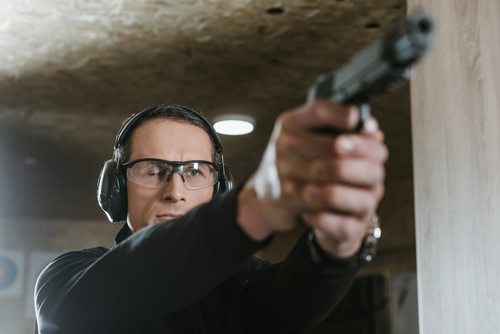Your parents may have warned you that listening to loud music could damage your hearing, but they probably didn’t tell you that it’s important to protect your ears from the sound of gunshots. According to the American Speech-Language-Hearing Association, any sound above 140 decibels can permanently damage your hearing. A small .22-caliber rifle can emit a noise around 140 decibels, while larger rifles and pistols can produce sound over 175 decibels. But unfortunately, only 58.5 percent of Americans use ear protection every time they fire a gun (source). So if you’re a recreational shooter, check out our overview of the types of ear protection for shooting.
Earmuffs and earplugs are two types of protective hearing devices, and both can be electronic or nonlinear.
Electronic earplugs and earmuffs make softer sounds louder, but they immediately shut off when there is a loud noise. These protective hearing devices are perfect for hunters and soldiers who need to be able to hear approaching animals or people. They come in earmuffs, custom-made in-the-ear devices, one-size-fits-all plugs, and even behind-the-ear devices.
Nonlinear protective hearing devices are not electronic. They allow soft and moderate sounds to pass through, but they still reduce the loud sounds. If you choose to go with nonlinear ear protection, look for a pair that has filters, which are more effective than mechanical valves. Unfortunately, mechanical valves don’t always close fast enough to adequately protect your hearing from a loud noise.
Both electronic and nonlinear hearing protective devices can safely protect your ears. In fact, the U.S. military uses both electronic and nonlinear hearing protective devices for soldiers’ ears. Electronic ear protection can be a big or a small investment depending on the product you select. You can get a basic pair of electronic earmuffs for around $100 dollars, or you can spend as much as $1,000 for a custom-made pair. Nonlinear ear protection ranges from $10–$20 for a basic pair or $100–$150 for a custom pair. Make sure to consult with your audiologist before buying ear protection for shooting. He or she will be able to help you choose the best pair for your situation.
So you’ve invested in a protective pair of earmuffs or earplugs – now what? Using your ear protection should be relatively easy, but we recommend that you employ these tips to get the most out of your purchase:
- If you’re using a big-bore firearm, double up your ear protection by putting earmuffs over earplugs. However, you should try to avoid using these loud firearms on a regular basis. Smaller caliber firearms are not as loud, and they are perfect for target practice and hunting.
- While a large hunting group trip might sound like fun, it can be detrimental to your hearing. The more people that are shooting near you, the more loud noises you’ll expose yourself to, even with your protective hearing device.
- Don’t rely on a pair of disposable earplugs for your ear protection. It is best to purchase a pair of high-quality electronic or linear earplugs or earmuffs. Your ability to hear is certainly worth the price tag.
If you’ve been an avid hunter for years, or you’ve been exposed to the sounds of gunshot as a soldier, there is a chance that your hearing has suffered. Sound trauma has a cumulative effect, which means the more often you expose your ears to a loud sound, the more damage that will occur over time. If you’re having trouble hearing higher pitched noises or you feel like the people around you are constantly mumbling, visit an audiologist.
Do you need help choosing ear protection for shooting? If you live near Pueblo, or Colorado Springs, Colorado, schedule a consultation with Apex Audiology today. Dr. William F. Herholtz will help you find the right hearing aid to fit your budget and needs. To get started, please call us at 719-247-9000 or schedule an appointment online. We look forward to connecting with you!




